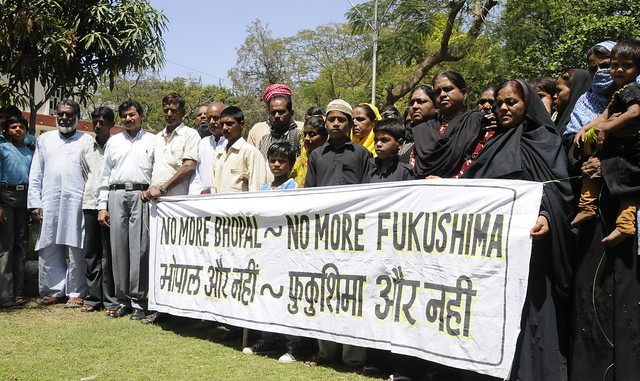Although the number of actual clearances given on paper for infrastructure projects are not much different compared to the UPA rule, the NDA rule seemed to have lost the perception battle owing to dilution of norms for environmental and forest clearances.
By Nivedita Bhardwaj, TwoCircles.net
New Delhi: “The Ministry of Environment and Forests worked sometimes with a green conscience and sometimes it functioned as a red ministry. No clearances were issued, decisions were delayed, there was also cherry picking, only selective projects were approved and there were other considerations. Delhi was abuzz with gossip and industry fears, it became the Ministry for holding back clearances.”
That was BJP leader Nirmala Sitharaman attacking Jayanthi Natarajan, former Environment Minister in the UPA regime, way back in January 2014. Sitharaman was defending the alleged remarks of “Jayanthi Tax” by Narendra Modi, then already declared as the BJP’s Prime Ministerial candidate in the run up to the April-May 2014 Lok Sabha polls.
The BJP leader further alleged that “in the past decade the MoEF has not been able to strike a balance between environmental protection and steps required for growth.” The allegation was then tilted in favour of the project proponents, whose projects were stalled/delayed by Natarajan and cleared by her successor (M Veerappa Moily). Environmental issues were unfortunately never the priority. Later at the time of elections, the BJP-led NDA had promised accelerated environmental clearances, rather called it as procedures.
It is almost 18 months after that. In between, BJP-led NDA romped home with a clear majority. Just last week, the government “celebrated” its first anniversary with much pomp and show. But the BJP’s allegation as to how the UPA government had not been able to “strike a balance between environmental protection and steps for growth” is equally holding true for the NDA government.

Experts have already warned that people’s resistance to large industrial projects or mines owing to issues mainly related to land, forest and water will only increase and India will witness more conflicts, this time brought in due to government relaxing the norms.
Within two months of taking over, in August 2014 to be precise, the government constituted a High Level Committee (HLC) under the chairmanship of former cabinet secretary TSR Subramanian “to review various acts administered by the Ministry of Environment, Forests and Climate Change.” Basically, what was asked of the HLC was to take a look at India’s core legislations to protect the environment. The process itself received flak with the manner in which public hearings/consultations were conducted, activists and environmentalists were up in arms against the Committee.
Much criticism later, the HLC submitted its report four months later but in between the government had started the process of dilution of laws or at times dismantling of norms that formed the basis of protecting the environment and always formed the core of clearances given for any kind of project. In fact, the activists and environmentalists had already started calling it as a “fast forwarding” ministry when it came to clearances for projects.
Suggestions by the HLC not just drew criticism but got “concerned” people worried. For instance, the Committee recommended that no field verification, with respect to forests, will be needed till stage I approval and also dispensed the mandatory approval of the gram sabha for diversion of forest land for linear projects that were for the community. The HLC also suggested that ‘forests’ will only be those areas that are notified by the government as ‘forest’, which effectively meant that any private plantation or gram sabha land which was not notified but has green cover will not be considered as forest.
Experts have already warned that people’s resistance to large industrial projects or mines owing to issues mainly related to land, forest and water will only increase and India will witness more conflicts, this time brought in due to government relaxing the norms. “In India, loss of forest cover is not just an environmental issue but an issue concerning livelihood and food security of the communities dependent on the forest,” says Ranjan Panda, an environmental activist and convenor of Water Initiatives, Odisha.
But one of the worst recommendations of the HLC was setting up of an administrative tribunal instead of a judicial National Green Tribunal (NGT) to review the clearances on appeal. Set up after Law Commission recommendation, the NGT today is acting as a real check on the haphazard policies and decisions of the various governments, central and states. In a country driven to work only after lashing by the Supreme Court, the NGT has, in its short life, proved to be a perfect foil for the government’s sinister plan to harm, if not destroy, the very environment it is supposed to protect.
Some good things too:
Of course, the government did some good things too.
The government is promoting solar energy and other renewable energy options in a big way. If whatever is promised – 100 GW solar power capacity by 2022 – this will help resolving a number of related issues, including poverty alleviation.
In April first week, a National Air Quality Index (AQI) was launched to provide real time air quality data in simple form. The AQI service is initially available for 10 major cities and will be later expanded to 60 cities.
Although it appears to have lost steam after the initial euphoria, but the Swachch Bharat Abhiyaan launched in 2014 is hoped to bring in at least awareness, if not total cleanliness, in general public.
And last but not the least, the government’s renewed focus on total sanitation vis-à-vis toilet constructions, though fraught with innumerable hurdles, is a laudable effort.
TCN series on One year of Modi sarkar

